|
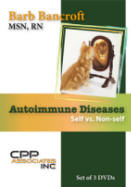
Autoimmune
Disease—Self vs. Non-Self
The
overall number of cases of autoimmune diseases is rising for unknown
reasons. The National Institutes of Health (NIH) estimates that 23.5
million Americans have an autoimmune disease. It is estimated that
80-100 diseases occur as a result of autoimmune responses. Women
represent 80% of people diagnosed with autoimmune diseases. Barb will
explain the normal healthy immune response and follow up with a
discussion of what can go wrong—when the immune system attacks one or
more of the body's normal constituents as if they were foreign. When the
immune system fails to recognize "self" it may produce autoantibodies
that target its own cells, tissues, and/or organs. Those attacks result
in inflammation and subsequent tissue damage that lead to autoimmune
disorders. Barb will discuss all of the “old” therapies and will
emphasize the newer therapies that have revolutionized the treatment of
many autoimmune disorders. A discussion of how lab tests can be used to
diagnose and follow treatment will be included. Autoimmune diseases to
be included: Systemic Lupus Erythematosus, Myasthenia Gravis,
Hashimoto’s thyroiditis, Grave’s disease, Crohn disease, Ulcerative
Colitis, Multiple Sclerosis, Rheumatoid Arthritis, Sjögren Syndrome, and
more…
Fall 20
"AW, That’s Just Because They’re Old…"
This DVD
is the perfect introduction to Geriatrics. Many “complaints” in
our older population tend to be dismissed as “old age”…when, in fact,
those “complaints” could be caused by the side effects of numerous
drugs, or the “complaints” could actually be a clinical disease process
that can be diagnosed and treated. “Barb, my muscles and joints are
killin’ me…” Could this simply be muscle aches and pains of “aging” or
are the muscle aches and pains due to a drug reaction, a vitamin D
deficiency, or a thyroid disorder? Is this patient’s memory loss due to
the “stacking effect” of the anti-cholinergic properties of the 12 drugs
they are taking, or does this patient have mild cognitive impairment? Is
this older patient dehydrated because of the loss of body water due to
the aging process or is this patient on a myriad of drugs that lead to
dehydration? Barb will sort through these and other case scenarios that
will make your students and staff THINK twice about saying…”AW, that’s
just because they’re old…”
Fall 2015
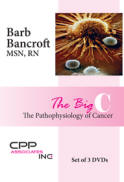
The
Big C—Pathophysiology of Cancer
This seminar provides an update and overview on the pathophysiology of
cancer–the growth and differentiation of normal tissue vs. the growth and
differentiation of a malignant tumor; how tumors metastasize; the role of
oncogenes (BRCA1, BRCA2, BRAF, and more), the oncogenic role of viruses (HPV,
HBV, HCV, EBV), bacteria {H. pylori}, and the roles of hormones,
chemicals, and radiation. The terms regeneration, hyperplasia, metaplasia, and
dysplasia will also be explained as will the role of chronic inflammation in the
pathogenesis of cancer. “Fertile soils” for the development of cancer, including
Barrett’s esophagus, chronic hepatitis C, and ulcerative colitis will be
discussed. Tumor markers (CA-125, HER-2, ER+, PR+, AFP, CEA) and their use for
diagnostic purposes will also be included. New drugs and old drugs will be
discussed—precision medicine, targeted therapies, biologicals including
monoclonal antibodies and tyrosine kinase inhibitors. How is the ZIKA virus
being used for glioblastoma multiforme? What is the actual contribution of
hormone therapy to breast cancer in women? What is the role of vitamin D in
prostate cancer? What is the “ugly duckling” sign? Specific cancers to be
discussed include breast cancer, prostate cancer, lung cancer, skin cancer,
hematologic malignancies, brain tumors and GI cancers. This seminar is full of
clinical pearls and quips about the big C.
Fall 2018
The Biological Clock—Implications for Clinical
Practice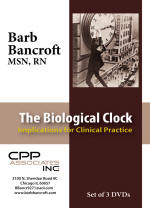
In this
most fascinating seminar, Barb discusses the
medical
and nursing implications of the 24-hour body clock. Barb starts at the
midnight hour and discusses, hour by hour, what the body clock does to
maintain your health. This seminar will answer many questions including:
-
Why
should the statins be given either with the evening meal or at
bedtime?
-
Why is metformin,
when given once daily, more effective if given in the evening?
-
How does Lithium
reset the biological clock in individuals with Bipolar illness?
-
When is your sense
of smell the highest? (In other words, when do you NOT want to
change a smelly wound dressing?)
-
Why are most
thrombotic events in the morning? (myocardial infarctions and
thrombotic strokes?)
-
Why does evening
GERD trigger nighttime asthma?
-
When do most people
have a bowel movement?
-
What is the Dawn
phenomenon?
-
Are you a “dipper”
or a “non-dipper”? When should blood pressure drugs be given? Should
aspirin be given in the morning or at night?
-
When is nocturia
(nighttime bathroom visits) clinically important?
-
Are you a lark,
owl, or hummingbird? Why do larks always marry owls?
-
What are the
effects of shift work on the biological clock? Who has the “best
clock” to work shifts? What drug is approved for “shift work
disorder”?
-
How does daylight
savings time shift your rhythms?
-
Should you bet on a
team that travels WEST to play the game or a team that travels EAST
to play a game? What does jet lag do to the body?
-
What are the costs
of shift work for the employer?
Spring 2017
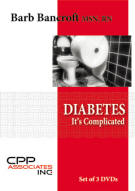 Diabetes—It's
Complicated Diabetes—It's
Complicated
Barb takes you on a trip down the Diabetic memory
lane—old names, old tests, and old treatments. She emphasizes what’s new in the
pathophysiology of Type 2 diabetes—it’s NOT just the traditional 3 underlying
mechanisms of insulin resistance, beta cell dysfunction, increased hepatic
glucose production—there are 5 more processes that contribute to Type 2
diabetes—accelerated lipolysis in the fat cells, incretin resistance/deficiency
in the small intestine, hyperglucagonemia (alpha cell failure), increased
glucose absorption by the proximal convoluted tubule of the kidney, and insulin
resistance in the brain (reducing the feeling of satiety and contributing to
dementia of the Alzheimer’s type)...YIKES...so yes! It’s complicated! We now have
10 classes of oral drugs, 3 types of injectable drugs, and even weight-loss
surgery to treat T2DM. Type 1 diabetes will also be discussed—pathophysiology,
basal-bolus insulin, and the prevention of long-term complications. Long-term
complications will be discussed for Type 2 diabetes as well. Lab tests will be
described and discussed. This is a MUST see DVD for all healthcare professionals
caring for the diabetic patient today. Total time: 6 hours
Fall 2016
ESTROGEN: Friend or Foe 
Estrogen, the “female”
hormone, has over 300 functions in practically all body tissues—including the
brain, the hypothalamus, the bones, the breasts, the uterus, the skin, the
immune system, the clotting system, and even adipose tissue. In this
presentation, Barb discusses the myriad of functions and correlates them with
clinical examples, as well as presenting the role of estrogen in pregnancy, in
puberty, in peri-menopause, and as a replacement hormone in postmenopausal
women. Estrogen plays an obvious role in autoimmune disease, as 75% of all
patients with autoimmune disease are women. Estrogen plays an obvious role in
breast cancer, as 99% of all breast cancer patients are women. Estrogen
fluctuations play an obvious role in migraine headaches as 60% are referred to as
“menstrual” migraines. Estrogen deficiency is a well-known risk factor for
osteoporosis. What are the symptoms of the lack of estrogen in the
postmenopausal female and how can those symptoms be alleviated? What are the
pros and cons of hormone therapy—based on the current evidence-based medicine? Fall 2014
This estrogen update is a must for all women interested in the role of
estrogen in health and disease.
Geriatric
Gems—Pathophysiology, Pharmacology, and Assessment Pearls
This one-day seminar
provides an in-depth discussion of essential aspects of caring for the geriatric
patient. Physiologic changes with aging are correlated with physical assessment
findings as well as side effects of common drugs used in the aging population.
An emphasis on neurologic function includes peripheral neuropathies, dementia
and delirium, movement disorders and the special senses. Type 2 diabetes and
thyroid dysfunction are covered in the Endocrine System. Reproductive changes
are gender specific and include causes of erectile dysfunction in the male and
menopausal changes in the female. Cardiovascular diseases include coronary
artery disease and atherosclerosis as well as hypertension and CHF. Respiratory
function briefly covers COPD and other age related changes in lung function. The
effect of NSAIDS in the GI system is emphasized as are the common causes of
constipation in the elderly population. The effect of a decreased glomerular
filtration rate and drug excretion is correlated with side effects and drug
toxicity. This lecture is presented in Barb's characteristically humorous
fashion and is a must for anyone working with and caring for Geriatric patients.
It truly is a "GEM" of a lecture.
Spring 2014
Infectious Diseases—What's
New?
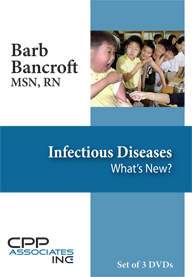 This one-day
seminar provides an up-to-the minute overview and update on current issues in
the world of infectious diseases. New vaccines, emerging diseases, new drugs!
Barb covers the important trends observed including
global warming, global economics, and travel; the increased number of food-borne
illnesses; diseases from animals to humans; the increased population of
immunocompromised patients; hospital-acquired infections; sexually-transmitted
diseases—old and new (including Baby Boomers Gone Wild); the overuse, misuse and
abuse of antibiotics; and the continued threat of bioterrorism. Learn about
rats, bats, camels, ticks, and mosquitos as vectors of disease. Learn the latest
information on pertussis (Tdap prevention!!), measles (MMR prevention!), C.
diff (NO MORE metronidazole—start with Vancomycin! Chronic C. diff?
Fecal Transplants, SARS, , HIV, H. Pylori, HCV and the opioid epidemic, MRSA
(how long does MRSA live on the keyboard of your computer?), VRE, CRE, and even
TB is making a comeback... What's new in vaccines—HPV and Gardasil-9, SHINGRIX—the
latest and greatest shingles vaccine, PReP for HIV prevention, and the new
"game-changing" Direct Antiviral Agents for Hepatitis C (we're now talking cure
for many HCV-infected patients). Barb also discusses the top food-borne
pathogens—norovirus, Salmonella, Listeria monocytogenes, E.Coli O157:H7,Toxoplasmosis
gondii. Join Barb for lots of laughs and lots of learning and the
overwhelming feeling of the need to wash your hands nonstop after hearing this
lecture.
Fall 2018
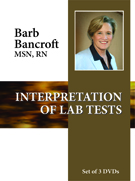
Interpretation
of Lab Tests
The safer, easier way to pay online!">
 reting lab tests is a "must
hear" for nurses in all areas and nurses at all levels. You will leave the
seminar with a plethora of practical pearls that can be applied to your patients
in the hospital, in the primary care facility, or in the ICU. The WBC and
differential is discussed as it relates to viral infections, bacterial
infections, and parasitic infections. Iron deficiency anemias will be
differentiated from B12 and folic acid anemias—and, Barb will give you some
helpful hints for patients with lead as a cause of anemia. The lipid profile
will be discussed as will liver function tests and clinical correlations. Barb
will also correlate various drugs with their effects on lab tests, including
chemotherapy, antibiotics, statins, and other lipid-lowering agents.
reting lab tests is a "must
hear" for nurses in all areas and nurses at all levels. You will leave the
seminar with a plethora of practical pearls that can be applied to your patients
in the hospital, in the primary care facility, or in the ICU. The WBC and
differential is discussed as it relates to viral infections, bacterial
infections, and parasitic infections. Iron deficiency anemias will be
differentiated from B12 and folic acid anemias—and, Barb will give you some
helpful hints for patients with lead as a cause of anemia. The lipid profile
will be discussed as will liver function tests and clinical correlations. Barb
will also correlate various drugs with their effects on lab tests, including
chemotherapy, antibiotics, statins, and other lipid-lowering agents.
Spring 2015
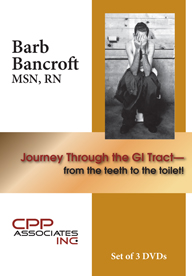
Journey
Through the GI Tract—from the teeth to the toilet
Join Barb for a day-long journey through
33 feet of gastrointestinal tract and a few associated structures. This
seminar covers the anatomy, physiology and pathophysiology of the GI
tract from top to bottom. Beginning with the mouth and oropharynx, this
lecture discusses the teeth, the tongue, the mouth, the gums, the
esophagus, the stomach, and the small and large bowel. Specific clinical
conditions include dysphasias, "burning tongue", vitamin deficiencies
and oral symptoms, esophageal varices and portal hypertension (and the
many causes of portal hypertension), eosinophilic esophagitis and food
allergies, the physiology of the lower esophageal sphincter (LES), drugs
and the LES, GERD and Barrett's esophagus, NSAID gastropathy, peptic
ulcer disease and H. pylori, Celiac disease and malabsorption, long-term
consequences of gastric surgery and gastric sleeves for weight loss,
pathogenesis and treatment of gastroparesis, the many causes of
gastroenteritis including C. difficile, food borne pathogens (norovirus,
Salmonella, C. jejuni), fecal transplants, the microbiome and
weight gain and loss, Crohn's disease, ulcerative colitis, appendicitis,
colon polyps and colorectal cancer (new screening recommendations!),
anal cancer and HPV infection, and those every pesky rectal foreign
objects. Barb discusses disease presentations as well as the newest
treatment modalities for the above clinical conditions. The journey is
entertaining, enlightening, and educational.
Fall 2018
Liver
Logic—50
ways to love your liver
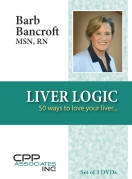
Did you know
that the liver has 500 functions and that it can regenerate itself within 30
days? Listen to Barb's fascinating lecture on the liver in all of its glory.
Barb takes you for a journey through an amazing organ that we tend to take for
granted. It metabolizes drugs, booze, and hormones...it synthesizes proteins,
clotting factors, and cholesterol...it stores blood, vitamins, and iron. Barb
discusses the many causes of hepatitis (viruses including A,B,C,E,F, EBV, CMV;
alcoholic hepatitis, autoimmune hepatitis), the many causes of cirrhosis
(alcohol, viruses, biliary), the signs and symptoms of acute and chronic liver
failure, and the treatment of all of the above. In addition, Barb discusses the
latest information on non-alcoholic fatty liver disease (NAFLD, NASH) and how to
prevent it as well as treat it. New “game changers” in the treatment of
hepatitis C as well as cirrhosis will be discussed. You will not only gain a new
respect for this 3.5-pound football-sized organ, you will also realize that it
is just as important as the more celebrated organ systems of the heart, lungs,
brain, and kidney. You “gotta” love your liver!
Summer 2015
 Neuro-for-the-not-so-neuro Minded Neuro-for-the-not-so-neuro Minded
The day includes an overview and update of functional
neuroanatomy and Neuro assessment. Barb takes a "journey" through the brain—the
Cerebral Cortex (all four lobes and their functions), and shows how to assess
the 4 lobes as well as pathophysiology, including head injuries, brain tumors,
and dementias; the basal ganglia and assessment, including the patient with a
movement disorder—Parkinson's disease, Huntington's chorea, and athetosis; the
brain stem—assessment and clinical correlations including cranial nerves; spinal
cord and the reflex arc. It's a great lecture for neuro novices as well as
seasoned neuro nurses—everyone learns some new tidbits as well as refreshing
some old tidbits.
Fall 2013
The
Neurology of Aging

Did you know
that you reach your peak mental capacity at age 24? And you have 6 good years.
You are a mental giant between the ages of 24 and 30, and then the "party is
over". But is it really? What happens the day after your 30th birthday? Pop a
blueberry in your mouth and continue reading this blurb. Barb will discuss the
changes occurring in the brain as it undergoes the process of senescence. What
are considered to be normal age-related declines in cognitive function? What can
you do NOW to delay this decline? How can you boost the brain's ability to
produce new neurons? New synapses? Barb will also discuss the common neurologic
diseases associated with aging, including the epidemiology, pathophysiology,
physical assessment, and pharmacologic management of each condition. Conditions
to be included: Dementia of the Alzheimer Type (DAT), nutritional dementias,
vascular dementias, Parkinson's disease, cerebrovascular disease, depression in
the elderly, mild cognitive impairment, dementia and more...What's new on the
horizon for the treatment of neurologic conditions in the elderly? How might the
"statin" drugs and metformin revolutionize the treatment of the aging brain?
Will anti-inflammatory drugs be used to treat Alzheimer's disease in the near
future? Join Barb for a delightful day of NEURO NUGGETS--for your own brain
health and for the brain health of your aging friends, your aging family and
your aging patients. And, don't forget to pop a blueberry in your mouth after
you finish reading this blurb.
Fall 2014
NEURO-through-the-Ages
from Autistic Spectrum Disorder to Alzheimer's Disease
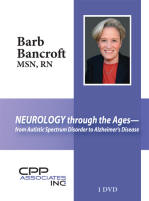 Barb
covers a myriad of conditions affecting embryologic development of the brain—the
influence of sex hormones on brain development, neurogenesis and plasticity, the
teratogenic effects of numerous drugs, genes, viruses, parasites, maternal
infections, hypothyroidism, vitamin deficiencies and paternal influences.
Clinical correlations include sex differences, FAS, toxoplasmosis, autistic
spectrum, schizophrenia, herpes infections, and neuroectodermal diseases.
Environmental exposure to lead levels as related to brain development,
behavioral disorders, and future criminal behavior is discussed. Mirror neurons
are described and correlated with disorders such as depression, bullying, child
abuse and autism. You will learn about the “teen-age” brain and how the limbic
system rules during those tumultuous years of brain development. Barb
covers a myriad of conditions affecting embryologic development of the brain—the
influence of sex hormones on brain development, neurogenesis and plasticity, the
teratogenic effects of numerous drugs, genes, viruses, parasites, maternal
infections, hypothyroidism, vitamin deficiencies and paternal influences.
Clinical correlations include sex differences, FAS, toxoplasmosis, autistic
spectrum, schizophrenia, herpes infections, and neuroectodermal diseases.
Environmental exposure to lead levels as related to brain development,
behavioral disorders, and future criminal behavior is discussed. Mirror neurons
are described and correlated with disorders such as depression, bullying, child
abuse and autism. You will learn about the “teen-age” brain and how the limbic
system rules during those tumultuous years of brain development.
Other neurological conditions
discussed include—seizure disorders, demyelinating diseases, and movement
disorders—athetosis, spasticity, Tourette’s syndrome, Huntington’s chorea and
Parkinson’s disease are described. Cerebellar disease as it relates to alcohol
and other neurologic conditions involving the cerebellum is also be included.And finally, Barb discusses the
aging brain and the top risk factors involved in the development of Alzheimer’s
dementia—inflammation, diabetes, hearing loss, and lack of sleep among others.
Fall 2015
Neurotransmitters in Health and Disease
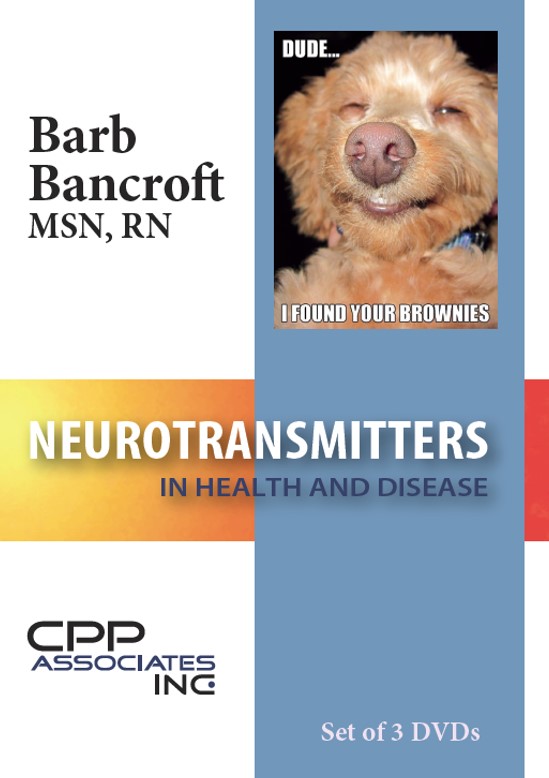 This
entertaining and educational presentation describes the functions of
numerous neurotransmitters in both the peripheral and central nervous
system. The transmitters include dopamine, serotonin, GABA,
norepinephrine, acetylcholine, and more. What are the many functions of
dopamine, in addition to the “Feel good, let’s do that again”
function…what is the addiction potential of various substances—
including methamphetamine, oxycontin, heroin, nicotine, alcohol and
marijuana? What is the role of dopamine in movement disorders, in the
delirium tremens and more? Did you know that 95% of all serotonin in the
body is in your GI tract? What is the bowel-brain connection? Does
serotonin play a role? Who’s your momma? GABA is! Her main function in
the brain is to say NO! She’s the major inhibitory transmitter in the
brain. What are some of the drugs that boost GABA? Mother’s Little
Helpers (the benzodiazepines), certain anti-convulsants, and more…learn
about antidepressants, antipsychotics, anticonvulsants, anticholinergics,
and every other “anti” in the medicine cabinet!
Summer 2017
Pharmacology—A Class
Act
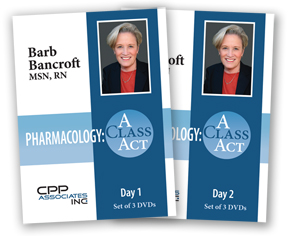
This 2-day MUST HAVE pharmacology
DVD is a perfect in-depth discussion of the principles of pharmacology as well
as an overview of the most common classes of drugs used in the world of medicine
and nursing today.
What will you learn on DAY 1? The top drugs prescribed; the
top money making drugs; the NEWEST “game changers” in the world of pharmacology;
the principles of drug absorption, distribution, metabolism, and excretion
correlated with a myriad of examples for each principle. Barb will also discuss
the process of senescence and its relationship to polypharmacy in the geriatric
population. You will also learn about drug-drug interactions and drug
interactions with herbal and OTC products.
What will you learn on the exciting
2nd day? Class after class after class (etc.) of drugs will be discussed
including: the ACE inhibitors, the ARBs, the Beta Blockers, the Calcium Channel
blockers, the Triptans, the PPIs, monoclonal antibodies, the “Statins”, the NIBs,
the H2 blockers, the ED drugs, the oxacins, and many, many more…how these drugs
work, their side effects and adverse effects... is there a better drug in each
class, if so, which one and why?
Summer 2015
Pharmacology—Simplify Don't Mystify
 This is a must have clinical DVD on the most common classes of
drugs used in the world of medicine and nursing today. Learn about the “prils”,
the “sartans”, the “triptans”, the “cyclovirs”, the “prazoles”, the “conazoles”,
the “olols, alols, and ilols”, and many more. Barb’s way of learning
Pharmacology is entertaining and enlightening and you’re sure to learn about
mechanisms of action, clinical indications, and adverse effects. Barb also
throws in a plethora of practical pearls for everyday use.
Summer 2016
Physical
Assessment Pearls—If
you only have 5 minutes…
The most important part of any physical exam is taking the patient’s
history. Learn how to Characterize the chief complaint by asking the right questions—the PQRST
+ AAA way. Barb provides examples of how to use this mnemonic to get the most
information in the least amount of time. Barb will then guide you through
assessment basics—where to “listen” if you only have a minute, where to “look”
if you only have a minute, where to “feel” if you only have a minute.
Barb
correlates anatomy, physiology and pathophysiology for each major system
discussed—the heart, the lungs, the abdomen, and the nervous system. The
differential diagnosis of acute abdominal pain will be described, breath sounds
related to asthma and pneumonia will be discussed, and heart sounds correlated
with common murmurs. You will also be amazed at the information you can glean
from basic vital sign evaluation. Last, but not least, Barb discusses various
drug classes and the side effects that can confound a physical exam.
Spring 2015
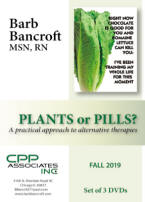
Plants or Pills?
A practical approach to alternative therapies
The
use of dietary supplements (nutraceuticals), herbal remedies, vitamins,
minerals, and other forms of complementary, alternative, and integrative
therapies are flourishing in today's world of medicine. All healthcare
professionals should be aware of the myriad of choices patients have at their
disposal--from the information (and misinformation) dispensed from the internet,
to the wide variety of health food stores, to the ability to purchase dubious
products from the “Marts”, and to borrowing homemade remedies from the
neighbor's medicine cabinet. Barb discusses the current studies supporting (or
not) the top 20 herbal products from Butterbur (migraines) to Chamomile flower
(colic in babies, anxiety in adults) to St John’s Wort (depression), Melatonin (sundowning,
sleep, cancer prevention?), and Valerian root (Nature's Valium). You'll hear the
pros and the cons, the adverse effects, as well as the interactions with
prescription drugs and lab tests. “Food as Pharmacy” has always been an option
suggested by healthcare professionals—the DASH diet and the Mediterranean diets
can't be beat for healthy eating—but what about the of KETO diet, PALEO diet,
the modified Atkin's diet, the Eat Right for Your Blood Type Diet, and more,
more, more diets? You'll be surprised at some of the newest information on the
KETO diet, as well as they myriad of benefits of coffee, the best nuts, and
other new tasty information on “Food as Pharmacy.” Barb will go through each of
the vitamins—the evidence-based findings for Vitamins A, all of the B's, C, D,
E, and K. Can you take too many vitamins? Can you overdose on a single vitamin?
What are the signs and symptoms or vitamin deficiency or vitamin excess?
Minerals such as magnesium and zinc will be discussed as to their various roles
in health and well-being. Should CoQ 10 and red yeast rice be used for high LDL
cholesterol? Find out about a surprising “alternative” treatment for menopausal
hot flashes (hint—You are getting very sleepy). Why do some women have reduced
hot flashes when using soy products and others don’t respond at all? What are
the benefits of meditation, acupuncture, massage therapy, sunlight, and humor?
Can the B vitamins keep your brain healthy? Do crossword puzzles really work?
How do you even pronounce Sudoku? What are the top alternative products that can
help reduce stress?
Fall 2019
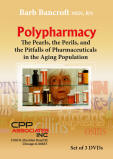
Polypharmacy
The Pearls, the Perils, and the
Pitfalls of Pharmaceuticals in the Aging Population
The whole new world of
Geriatric Pharmacology awaits you! It has been estimated that 28% of all
hospitalizations in the elderly are due to adverse drug reactions. And right
along with that fact it has been estimated that each older patient has 6.5
chronic conditions with an average of 3-5 drugs prescribed to treat each
condition. YOU DO THE MATH. Barb will discuss the normal physiologic changes of
aging that play a major role in drug absorption, distribution, and excretion.
You will learn the most common disastrous drug combinations and how to avoid
them—and you will learn what drugs can be substituted, deleted, and/or added to
avoid drug-related disasters. How can something as simple as ibuprofen throw an
80-year-old into renal failure? How can a single dose of cimetidine send a
90-year-old into a state of delirium? Summer 2016
Unstress for Success
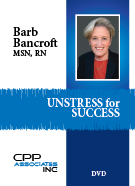 Did you know that stress moves
FAT to your waistline? Did you know that stress depletes the brain for the
“happiness” neurotransmitter serotonin and the “zippy” neurotransmitter
norepinephrine? Did you know that stress can move calcium out of the bone and
increase the risk of osteoporosis? Did you know that stress is directly
cytotoxic to neurons of the hippocampus and can lead to memory loss? Did you
know that stress increases your blood pressure? Are you stressed reading this
blurb on stress? Join Barb for a delightful review of the “stress response” and
its ramifications for health and happiness. A little bit of stress has a
positive effect…high levels of continued stress is quite harmful. Barb will not
only discuss the implications of stress on health and disease, but she will also
provide hilarious ways to reduce stress in your daily routine.
Fall 2015
A Few Miscellaneous DVDs
The Aging
Heart (The Old
Ticker)
(The Old
Ticker)
The majority of patients with cardiovascular disease are individuals
over the age of 65. Barb will discuss how the process of senescence
affects the cardiovascular system as we age—cardiac output, heart rate
(SA node), stroke volume, response to epinephrine...and more..Almost all
of your questions will be answered...but here are some that will
definitely be answered:
What is the role of troponin in diagnosing an acute coronary
syndrome? • What are the new "game changing" drugs for heart failure? •
What is the role of the thyroid gland in heart disease? • What is the
risk of having a heart attack during sex? • What is the difference
between systolic and diastolic heart failure? • What rare the body's
compensatory mechanisms in heart failure? • What are the risk factors
for heart disease as we age? • What are some pharmaceutical pearls from
the following drugs? ACE inhibitors, NTC, Calcium channel blockers, ASA,
clopidogrel, heparin, statins, beta blockers, estrogen, synthroid,
spironolactone, dig, anticoagulants, and NSAIDS. Summer 2016
Endocrine Update and
Overview—Hormonal Chaos
It’s all about
“too much or too little” in the world of endocrinology. Barb discusses the
hypothalamus and it’s myriad of functions—sleep, sex, temperature regulation,
onset of puberty, body rhythms, appetite, satiety, sexual orientation and
more…Clinical correlations include drugs and the hypothalamus (aspirin,
acetaminophen, diet pills, sleeping pills, gonadotropin-releasing hormones) as
well as primary, secondary, and tertiary diseases of the hypothalamus. The
hypothalamic-pituitary-target organ (thyroid, adrenal gland, gonads) axis will
be discussed as well as clinical conditions involved with each target organ.
Clinical conditions include hypopituitarism, hyper-and hypothyroidism, hyper-and
hypoparathyroidism, Cushing’s disease and Cushing’s syndrome, Addison’s disease,
primary ovarian failure and primary testicular failure, polycystic ovary
syndrome, endometriosis, cancers of the endocrine system, and dysfunction of the
endocrine portion of the pancreas (hyperglycemia and hypoglycemia). The concept
of negative feedback will also be discussed and correlated with various types of
tests used to diagnose endocrine function and dysfunction. Barb will also
discuss the treatment of all of the above conditions. Drugs to be discussed
include the various hormonal therapies for endocrine cancers, the types of
glucocorticoids and their potency profile, metformin, levothyroxine, androgen,
and estrogen replacement therapies.
Interpretation of Lab Tests with a Pharmaceutical Focus
White counts, liver function tests, TSH,
electrolytes, platelets, serum creatinine...how do drugs change the
interpretation of lab tests in a patient and how do we monitor specific
drugs based on lab test changes? What drugs cause low sodium? Can
prescription drugs as well as complementary therapies wreak havoc with
potassium levels? What should the sed rate do when antibiotic treatment
is initiated? What drugs "kill" the thyroid? A myriad of drugs induce
direct liver injury—what are the most common prescription and
non-prescription drugs that cause liver damage? What drugs and
supplements affect lipid metabolism? What should the TSH do once a
patient begins thyroid replacement? Why do ACE inhibitors increase the
serum creatinine? Which lab test should be used to monitor muscle aches
and pains in patients on "statin" therapy? What drugs are notorious for
reducing platelet counts? What drugs cause megaloblastic anemia? Heck,
what IS megaloblastic anemia? Which drugs induce life threatening
neutropenia? How does Neulasta work? You'll not only understand the
effects of drugs on lab tests—you'll also finally understand LAB TESTS!
|



